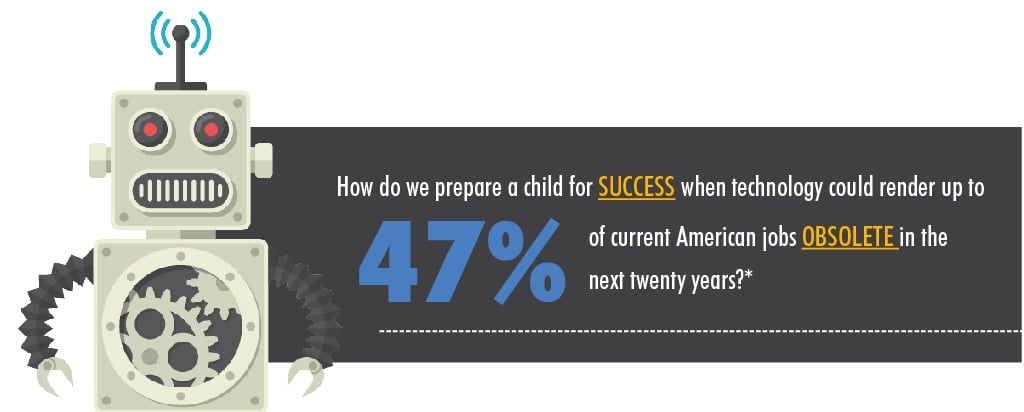Raising Children for the Rise of Robots

How do you prepare your child for the rise of robots?
We had it easy. You graduated college, you started your career. You worked your way up the ladder.
Our children on the other hand are living with fear of student debt, not knowing if there will be a job once they graduate, and wondering if their entire industry of choice might be displaced by advanced robotics and artificial intelligence.
We need to prepare our children from this tectonic shift from industrial economy to digital economy by raising entrepreneurs. This means we need to get our children to think, create, and innovate — which are functions that can't be automated.
Teaching innovation requires children filtering copious data to come up with salient points and solutions. It requires problem solving across typical —
and often accepted — divides.
As parents, we need to look a the gap between an education system that was designed for the industrial economy and a reality that is digital — and dynamic. Helping steer students to their passions can save frustration — and money.
We tested the approach of design thinking into our student programs this summer and found that students collaborated in a way that even their parents would not have.
Where there is great disruption, there is great opportunity. And our children's generation will be able to reimagine institutions and businesses in a more wired world, with 2-3 billion more people on the world wide web in the next 20 years.
How do parents and educators prepare their children for a world that is changing faster than education? What job training is relevant when the jobs economy is switching — rapidly — from industrial to digital?
We need to raise entrepreneurs — thinkers and actors that can create and innovate in a function that can’t be automated,” Andrew Potter said. “We tested the approach of design thinking into our programs this summer and found that students collaborated in a way that even their parents would not have.”
According to a report from the outgoing Obama administration in December 2016, the development in robotics and artificial intelligence could cost up to 47% of American jobs — something that the students feel as they look at their job prospects.
In their papers, students of generation now spoke in terms of acceptance of automation, www.EnvisionGenerationNow.com, conveying a familiarity and acceptance with computer technology that their preceding generations may have lacked. However, they saw new problems about regulation, warning against invasions of privacy and lack of regulation.
These suggestions illustrate possible new fields of jobs, just as the introduction of the tractor to farming created a new supply chain, even as it automated previously human work.
Unlike their parents and their international peers, Generation Now knows of the promise and disruption of technology, using their proposals to safeguard their privacy:
- The students propose drone registration at a DMV
- Seeing privacy limited, they ask to block off school zones from drones
- They see automation affecting jobs across racial and territorial boundaries

